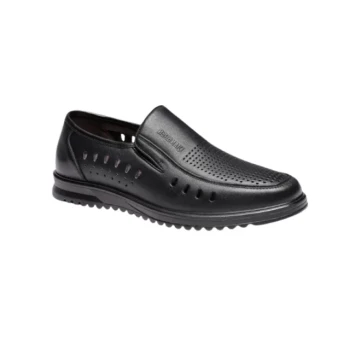At its core, leather shoe craftsmanship has evolved from a rudimentary survival skill into a sophisticated art form that meticulously balances function, style, and comfort. What began as simple leather wraps for protection has become a complex process involving specialized components and techniques refined over centuries.
The true evolution of shoemaking is not just about changing styles, but about the increasing specialization of each component—the upper, lining, sole, and heel—and how they are integrated to create a product that is both durable and perfectly suited to the wearer.
From Primitive Necessity to Refined Craft
The journey of the leather shoe mirrors the journey of human civilization. Its purpose has expanded from pure utility to a nuanced expression of personal style and engineering.
The Survivalist Era
Initially, leatherwork was a basic necessity for creating tools, shelter, and rudimentary clothing. The earliest footwear was simply a piece of hide wrapped around the foot, designed for one purpose: protection from the elements.
The Rise of Specialization
As societies developed, so did the craft. Shoemaking became a dedicated profession, with artisans focusing on creating better-fitting and more durable footwear. This shift marked the beginning of true craftsmanship, moving beyond mere function.
The Modern Synthesis
Today, a master shoemaker is both an artist and an engineer. The craft supports a combination of function, fashion, and lifestyle, blending traditional techniques with a deep understanding of materials and human anatomy.
The Anatomy of Modern Craftsmanship
The evolution of the shoe is best understood by looking at its individual parts. Each component has been refined over time to serve a specific and critical role.
The Upper: Structure and Style
The upper is the main body of the shoe that you see. Its evolution has focused on creating a piece that provides both structural integrity and aesthetic appeal. Modern craftsmanship is evident in the precision of the cut and the quality of the stitching.
The Lining: The Pursuit of Comfort
The lining is the material on the inside of the shoe. The addition and refinement of the lining represent a major evolutionary leap towards prioritizing the wearer's comfort, reducing friction, and managing moisture.
The Sole: The Foundation of Durability
The sole provides traction and protects the foot from the ground. Craftsmanship has evolved from simple, single-layer soles to complex, multi-layered constructions that enhance durability, flexibility, and support.
The Heel: The Engineering of Balance
The heel provides lift and stability. Once a simple block, it has evolved to become a precisely engineered component that affects posture and gait, balancing the shoe and completing its silhouette.
Understanding the Trade-offs
Recognizing quality craftsmanship also means understanding the compromises made in modern manufacturing, where the goals of the artisan differ from those of mass production.
Mass Production vs. Artisan Skill
Mass-produced shoes prioritize speed and cost-efficiency, often using cements and lower-grade materials. True craftsmanship, in contrast, prioritizes longevity and fit, using time-consuming techniques and superior materials, which naturally results in a higher cost.
Style vs. Pure Function
Sometimes, a design choice made for fashion can compromise the shoe's long-term comfort or durability. The hallmark of a truly evolved design is its ability to deliver a distinct style without sacrificing the fundamental principles of good construction and ergonomic support.
How to Recognize Quality Craftsmanship Today
Use your understanding of this evolution to assess any leather shoe.
- If your primary focus is durability: Examine the sole's attachment and the density of the stitching on the upper.
- If your primary focus is comfort: Pay close attention to the quality of the lining material and the shoe's flexibility out of the box.
- If your primary focus is style: Look for precision in the details, like clean stitch lines and the flawless finish of the leather.
By appreciating its components, you can see a well-made shoe not just as an accessory, but as the result of a long and deliberate evolution of craft.
Summary Table:
| Era | Focus | Key Development |
|---|---|---|
| Survivalist | Pure Protection | Simple hide wraps for the foot. |
| Specialization | Durability & Fit | Shoemaking becomes a dedicated profession. |
| Modern Synthesis | Function, Fashion & Lifestyle | Integration of artistry, engineering, and anatomy. |
Ready to Experience Evolved Craftsmanship?
As a large-scale manufacturer, 3515 produces a comprehensive range of footwear for distributors, brand owners, and bulk clients. Our production capabilities, honed over decades, encompass all types of shoes and boots, blending time-tested techniques with modern efficiency to deliver superior quality, durability, and style.
Let us help you bring expertly crafted footwear to your market. Contact our team today to discuss your production needs.
Related Products
- Wholesale Leather Business Casual Shoes with Dial Closure - Manufacturer of Comfort Dress Sneakers
- Wholesale Comfort Leather Business Shoes with Dial Lacing System
- Wholesale Leather Work Boots with Customizable Wedge Sole for Brands
- Durable Leather Work Boots for Wholesale & Custom OEM Manufacturing
- Durable Leather Work Boots Wholesale Manufacturer & Custom Factory
People Also Ask
- How often should business casual shoes be rotated? Maximize Longevity with Proper Care
- What should be known about genuine leather for shoes? Don't Be Misled by the Label
- What are the key features of high-quality leather in shoes? Invest in Durability and a Perfect Fit
- How can one identify authentic leather footwear? A Guide to Spotting Genuine vs. Fake
- How should business casual shoes be maintained? A Proactive System for Longevity & Style



















